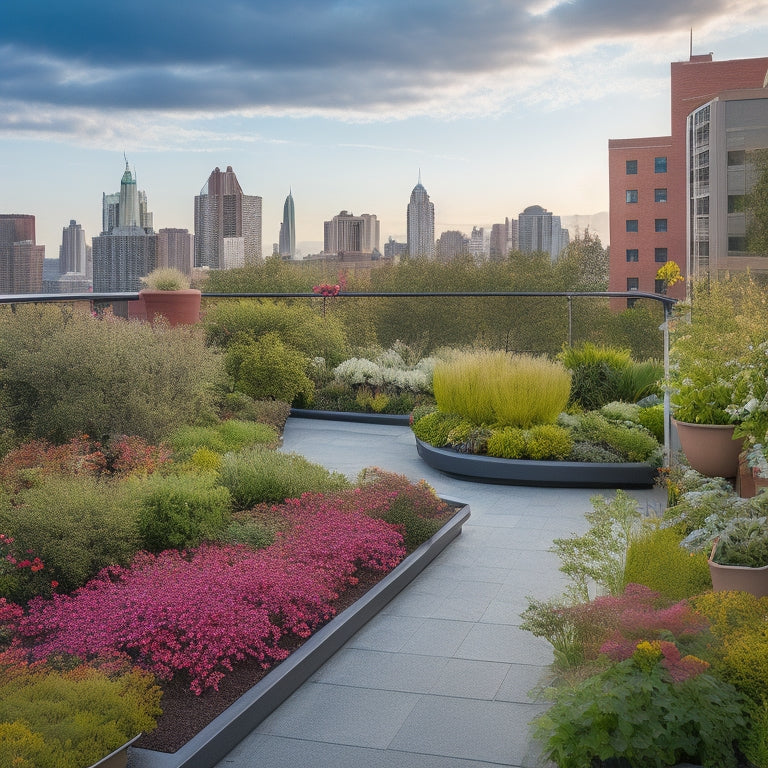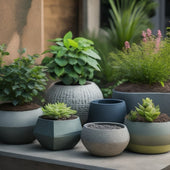
3 Essential Tips for Sloping Rooftop Gardens
Share
When designing a sloping rooftop garden, you'll need to tackle three critical challenges head-on: accurately evaluating the rooftop's slope and structural integrity by measuring vertical rise and assessing the material's condition; selecting plant species that thrive in these unique conditions, considering factors like drought-resistance and mature size; and implementing a robust water management and drainage system to prevent waterlogged soil and erosion, using tools like drip irrigation and drainage mats. By mastering these essential tips, you'll be well on your way to creating a thriving, well-engineered oasis that's both beautiful and functional, with many nuances to discover.
Key Takeaways
• Measure rooftop slope and structural integrity to ensure a safe and stable garden environment.
• Select plant species that thrive in sloping conditions, considering sunlight, water exposure, and mature size.
• Implement a robust water management and drainage system to prevent waterlogged soil and structural damage.
• Design an irrigation schedule based on rooftop slope, plant types, and soil conditions for efficient water delivery.
• Monitor drainage solutions regularly to redirect excess water and prevent accumulation.
Assessing Slope and Structural Integrity
Before designing your sloping rooftop garden, determine the degree of slope by measuring the vertical rise in inches per horizontal foot. Then, assess the structural integrity of your rooftop by evaluating its capacity to support the added weight of soil, plants, and water. This vital step will guarantee your garden doesn't compromise the building's stability.
For an accurate slope assessment, take multiple measurements across the rooftop, noting the highest and lowest points. Calculate the average slope to determine the ideal layout for your garden.
When evaluating structural considerations, consider the rooftop's material, age, and condition. Check for any signs of wear, cracks, or water damage. Consult with a structural engineer or architect if you're unsure about your rooftop's capacity.
They can help you determine the maximum weight your rooftop can support and recommend necessary reinforcements. Remember, a thorough slope assessment and structural evaluation are essential to creating a safe and thriving sloping rooftop garden.
Choosing the Right Plant Species
Selecting plant species that thrive in sloping conditions and can tolerate varying degrees of sunlight, wind, and water exposure is essential for creating a resilient and visually stunning rooftop garden. It's important to take into account factors like soil depth, moisture levels, and temperature fluctuations when making your choices.
When choosing plants, consider native plant options that are naturally adapted to your region's climate and soil conditions. These plants will require less maintenance and care, as they're already well-suited to the environment.
Drought-resistant varieties are also an excellent choice, as they'll be more resilient to water scarcity and fluctuations in moisture levels.
Consider the mature size of each plant, making sure they won't overgrow the rooftop space or compromise the structural integrity of the building.
You'll also want to think about the plant's growth habits, such as spreaders or climbers, to make sure they won't encroach on neighboring plants or structures.
Water Management and Drainage
As you design your sloping rooftop garden, you'll need to implement a robust water management and drainage system to prevent waterlogged soil, erosion, and structural damage to the building. This is particularly essential due to the sloping nature of your rooftop, which can cause water to flow rapidly towards the lowest points.
To address this, you'll need to incorporate effective drainage solutions, such as a waterproofing membrane, drainage mats, or a green roof drainage system. These solutions will help to redirect excess water away from the rooftop and prevent accumulation.
When designing your irrigation systems, consider using a drip irrigation or soaker hose system, which delivers water directly to the roots of the plants, reducing evaporation and runoff.
Additionally, make sure that your irrigation schedule takes into account the slope of your rooftop, as well as the type of plants and soil you're using.
Frequently Asked Questions
How Often Should I Inspect My Rooftop Garden for Damage or Issues?
You should inspect your rooftop garden regularly, ideally every 2-3 months, to perform a thorough damage assessment, checking for signs of wear, cracks, and water accumulation, adjusting your inspection frequency based on weather conditions and plant growth.
Can I Use Regular Gardening Tools on a Sloping Rooftop Garden?
Just as a rock climber adapts their gear for a steep ascent, you'll need to modify your tools for a sloping rooftop garden. Regular gardening tools won't cut it; you'll require adaptations for slope drainage and stability to guarantee a secure harvest.
Are There Any Specific Safety Precautions for Rooftop Garden Maintenance?
When maintaining your rooftop garden, you'll need to prioritize safety; wear safety gear like harnesses and gloves, and guarantee ladder stability by securing it to the roof or using a leveler to prevent slipping.
How Do I Prevent Pests and Diseases From Spreading in My Rooftop Garden?
While enjoying the serenity of your rooftop oasis, you're suddenly faced with unwelcome visitors - pests and diseases! To regain control, you'll need to implement a solid pest management strategy and disease prevention plan, incorporating techniques like crop rotation and biological controls.
Can I Install a Rooftop Garden on a Rented Property or Apartment?
Before installing a rooftop garden on a rented property, you'll need to review your lease agreements and research local rooftop regulations to guarantee you're not violating any terms or codes, getting necessary permissions first.
Related Posts
-

10 Essential Steps to Upcycle Concrete Planters
You've decided to breathe new life into those old concrete planters lying around, and you're ready to transform them ...
-

10 Essential Steps to Upcycle Concrete Planters
You've decided to breathe new life into those old concrete planters lying around, and you're ready to transform them ...
-

10 Essential Steps to Upcycle Concrete Planters
You've decided to breathe new life into those old concrete planters lying around, and you're ready to transform them ...
-

10 Essential Steps to Upcycle Concrete Planters
You've decided to breathe new life into those old concrete planters lying around, and you're ready to transform them ...
-

10 Essential Steps to Upcycle Concrete Planters
You've decided to breathe new life into those old concrete planters lying around, and you're ready to transform them ...
-

10 Essential Steps to Upcycle Concrete Planters
You've decided to breathe new life into those old concrete planters lying around, and you're ready to transform them ...
-

10 Essential Steps to Upcycle Concrete Planters
You've decided to breathe new life into those old concrete planters lying around, and you're ready to transform them ...
-

10 Essential Steps to Upcycle Concrete Planters
You've decided to breathe new life into those old concrete planters lying around, and you're ready to transform them ...
-

10 Essential Steps to Upcycle Concrete Planters
You've decided to breathe new life into those old concrete planters lying around, and you're ready to transform them ...
-

10 Essential Steps to Upcycle Concrete Planters
You've decided to breathe new life into those old concrete planters lying around, and you're ready to transform them ...
-

10 Essential Steps to Upcycle Concrete Planters
You've decided to breathe new life into those old concrete planters lying around, and you're ready to transform them ...
-

10 Essential Steps to Upcycle Concrete Planters
You've decided to breathe new life into those old concrete planters lying around, and you're ready to transform them ...
-

10 Essential Steps to Upcycle Concrete Planters
You've decided to breathe new life into those old concrete planters lying around, and you're ready to transform them ...
-

10 Essential Steps to Upcycle Concrete Planters
You've decided to breathe new life into those old concrete planters lying around, and you're ready to transform them ...
-

10 Essential Steps to Upcycle Concrete Planters
You've decided to breathe new life into those old concrete planters lying around, and you're ready to transform them ...
-

10 Essential Steps to Upcycle Concrete Planters
You've decided to breathe new life into those old concrete planters lying around, and you're ready to transform them ...
-

10 Essential Steps to Upcycle Concrete Planters
You've decided to breathe new life into those old concrete planters lying around, and you're ready to transform them ...
-

10 Essential Steps to Upcycle Concrete Planters
You've decided to breathe new life into those old concrete planters lying around, and you're ready to transform them ...
-

10 Essential Steps to Upcycle Concrete Planters
You've decided to breathe new life into those old concrete planters lying around, and you're ready to transform them ...
-

10 Essential Steps to Upcycle Concrete Planters
You've decided to breathe new life into those old concrete planters lying around, and you're ready to transform them ...
-

10 Essential Steps to Upcycle Concrete Planters
You've decided to breathe new life into those old concrete planters lying around, and you're ready to transform them ...
-

10 Essential Steps to Upcycle Concrete Planters
You've decided to breathe new life into those old concrete planters lying around, and you're ready to transform them ...
-

10 Essential Steps to Upcycle Concrete Planters
You've decided to breathe new life into those old concrete planters lying around, and you're ready to transform them ...
-

10 Essential Steps to Upcycle Concrete Planters
You've decided to breathe new life into those old concrete planters lying around, and you're ready to transform them ...
-

10 Essential Steps to Upcycle Concrete Planters
You've decided to breathe new life into those old concrete planters lying around, and you're ready to transform them ...
-

10 Essential Steps to Upcycle Concrete Planters
You've decided to breathe new life into those old concrete planters lying around, and you're ready to transform them ...
-

10 Essential Steps to Upcycle Concrete Planters
You've decided to breathe new life into those old concrete planters lying around, and you're ready to transform them ...
-

10 Essential Steps to Upcycle Concrete Planters
You've decided to breathe new life into those old concrete planters lying around, and you're ready to transform them ...
-

10 Essential Steps to Upcycle Concrete Planters
You've decided to breathe new life into those old concrete planters lying around, and you're ready to transform them ...
-

5 Best DIY Planter Ideas to Upcycle Concrete
You're about to breathe new life into discarded concrete blocks by transforming them into functional and visually app...
-

5 Best DIY Planter Ideas to Upcycle Concrete
You're about to breathe new life into discarded concrete blocks by transforming them into functional and visually app...
-

5 Best DIY Planter Ideas to Upcycle Concrete
You're about to breathe new life into discarded concrete blocks by transforming them into functional and visually app...
-

5 Best DIY Planter Ideas to Upcycle Concrete
You're about to breathe new life into discarded concrete blocks by transforming them into functional and visually app...
-

5 Best DIY Planter Ideas to Upcycle Concrete
You're about to breathe new life into discarded concrete blocks by transforming them into functional and visually app...
-

5 Best DIY Planter Ideas to Upcycle Concrete
You're about to breathe new life into discarded concrete blocks by transforming them into functional and visually app...
-

5 Best DIY Planter Ideas to Upcycle Concrete
You're about to breathe new life into discarded concrete blocks by transforming them into functional and visually app...
-

5 Best DIY Planter Ideas to Upcycle Concrete
You're about to breathe new life into discarded concrete blocks by transforming them into functional and visually app...
-

5 Best DIY Planter Ideas to Upcycle Concrete
You're about to breathe new life into discarded concrete blocks by transforming them into functional and visually app...
-

5 Best DIY Planter Ideas to Upcycle Concrete
You're about to breathe new life into discarded concrete blocks by transforming them into functional and visually app...
-

5 Best DIY Planter Ideas to Upcycle Concrete
You're about to breathe new life into discarded concrete blocks by transforming them into functional and visually app...
-

5 Best DIY Planter Ideas to Upcycle Concrete
You're about to breathe new life into discarded concrete blocks by transforming them into functional and visually app...
-

5 Best DIY Planter Ideas to Upcycle Concrete
You're about to breathe new life into discarded concrete blocks by transforming them into functional and visually app...
-

5 Best DIY Planter Ideas to Upcycle Concrete
You're about to breathe new life into discarded concrete blocks by transforming them into functional and visually app...
-

5 Best DIY Planter Ideas to Upcycle Concrete
You're about to breathe new life into discarded concrete blocks by transforming them into functional and visually app...
-

5 Best DIY Planter Ideas to Upcycle Concrete
You're about to breathe new life into discarded concrete blocks by transforming them into functional and visually app...
-

5 Best DIY Planter Ideas to Upcycle Concrete
You're about to breathe new life into discarded concrete blocks by transforming them into functional and visually app...
-

5 Best DIY Planter Ideas to Upcycle Concrete
You're about to breathe new life into discarded concrete blocks by transforming them into functional and visually app...
-

Accurate Measuring for DIY Block Planters Made Easy
As you begin building a DIY block planter, precise measurement is essential for a sturdy structure that can support s...
-

Accurate Measuring for DIY Block Planters Made Easy
As you begin building a DIY block planter, precise measurement is essential for a sturdy structure that can support s...
-

Accurate Measuring for DIY Block Planters Made Easy
As you begin building a DIY block planter, precise measurement is essential for a sturdy structure that can support s...
-

Accurate Measuring for DIY Block Planters Made Easy
As you begin building a DIY block planter, precise measurement is essential for a sturdy structure that can support s...
-

Accurate Measuring for DIY Block Planters Made Easy
As you begin building a DIY block planter, precise measurement is essential for a sturdy structure that can support s...
-

Accurate Measuring for DIY Block Planters Made Easy
As you begin building a DIY block planter, precise measurement is essential for a sturdy structure that can support s...
-

Accurate Measuring for DIY Block Planters Made Easy
As you begin building a DIY block planter, precise measurement is essential for a sturdy structure that can support s...
-

Accurate Measuring for DIY Block Planters Made Easy
As you begin building a DIY block planter, precise measurement is essential for a sturdy structure that can support s...
-

Accurate Measuring for DIY Block Planters Made Easy
As you begin building a DIY block planter, precise measurement is essential for a sturdy structure that can support s...
-

Accurate Measuring for DIY Block Planters Made Easy
As you begin building a DIY block planter, precise measurement is essential for a sturdy structure that can support s...
-

Accurate Measuring for DIY Block Planters Made Easy
As you begin building a DIY block planter, precise measurement is essential for a sturdy structure that can support s...
-

Accurate Measuring for DIY Block Planters Made Easy
As you begin building a DIY block planter, precise measurement is essential for a sturdy structure that can support s...
-

Accurate Measuring for DIY Block Planters Made Easy
As you begin building a DIY block planter, precise measurement is essential for a sturdy structure that can support s...
-

Accurate Measuring for DIY Block Planters Made Easy
As you begin building a DIY block planter, precise measurement is essential for a sturdy structure that can support s...
-

Accurate Measuring for DIY Block Planters Made Easy
As you begin building a DIY block planter, precise measurement is essential for a sturdy structure that can support s...
-

Accurate Measuring for DIY Block Planters Made Easy
As you begin building a DIY block planter, precise measurement is essential for a sturdy structure that can support s...
-

Accurate Measuring for DIY Block Planters Made Easy
As you begin building a DIY block planter, precise measurement is essential for a sturdy structure that can support s...
-

Accurate Measuring for DIY Block Planters Made Easy
As you begin building a DIY block planter, precise measurement is essential for a sturdy structure that can support s...
-

Accurate Measuring for DIY Block Planters Made Easy
As you begin building a DIY block planter, precise measurement is essential for a sturdy structure that can support s...
-

Accurate Measuring for DIY Block Planters Made Easy
As you begin building a DIY block planter, precise measurement is essential for a sturdy structure that can support s...
-

Accurate Measuring for DIY Block Planters Made Easy
As you begin building a DIY block planter, precise measurement is essential for a sturdy structure that can support s...
-

Accurate Measuring for DIY Block Planters Made Easy
As you begin building a DIY block planter, precise measurement is essential for a sturdy structure that can support s...
-

Accurate Measuring for DIY Block Planters Made Easy
As you begin building a DIY block planter, precise measurement is essential for a sturdy structure that can support s...
-

Accurate Measuring for DIY Block Planters Made Easy
As you begin building a DIY block planter, precise measurement is essential for a sturdy structure that can support s...
-

Accurate Measuring for DIY Block Planters Made Easy
As you begin building a DIY block planter, precise measurement is essential for a sturdy structure that can support s...
-

Accurate Measuring for DIY Block Planters Made Easy
As you begin building a DIY block planter, precise measurement is essential for a sturdy structure that can support s...
-

Accurate Measuring for DIY Block Planters Made Easy
As you begin building a DIY block planter, precise measurement is essential for a sturdy structure that can support s...


